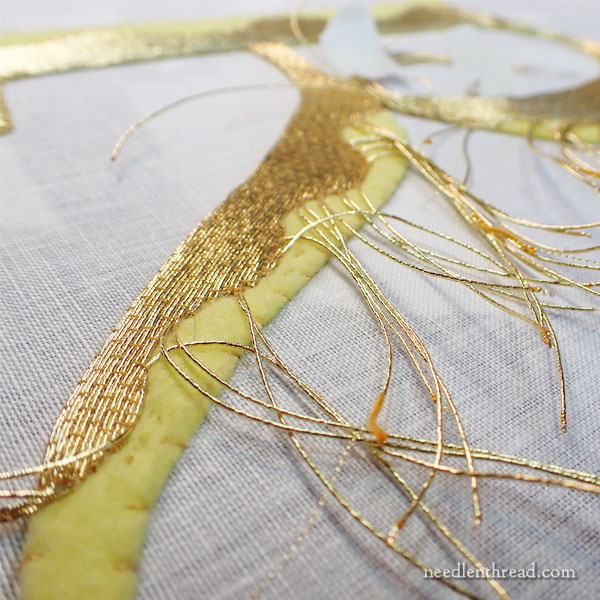The title might not be perfectly accurate.
But when you’re doing goldwork – endlessly couching double strands of passing thread – couching, couching, couching – it sure begins to feel like R is the biggest letter in the world.
Last weekend was a holiday weekend here in the States, and I used a portion of all three days to get the rest of the smooth passing thread couched down on this R. In the three days, I put in about 15 hours on the R, which was already well under way.
I can’t figure out why it took so much time! I think I was in Molasses Mode.

In the previous article on this project, the R was underway, but not nearly finished.
Now, the smooth passing thread part of the R is finished. All those gold threads are couched, for better or for worse.
There’s one maddening thread that is twisted. I didn’t see it while I was working, but when I turned the light off, I saw its shadow, and running my finger over the top of the gold, I could feel that there’s a twisted thread.
So out came the magnifier. I poked and prodded to remedy the situation. I managed to minimize the noticeability of the discombobulated thread, but I didn’t manage to fix it altogether. It will be one of those “Only I will see it” (I hope) problems.

There’s definitely more surface area to the R, so that’s one reason it took an impossibly long time to get the passing thread finished.
There are also three areas of wavy insets, which require working with very small pieces of the gold passing thread, with many starts and stops in order to fill the hills and valleys.
Once I started plunging, I was much happier with overall progress. There’s something about getting those ends to the back and seeing the smooth passing thread without all the hairy bits around it! It just looks much more complete and satisfying!

You can see I have tape on the back of the fabric, too.
I’m a tape hog when I do this kind of stuff! I tape the hairy ends out of the way, front and back. The hairy ends don’t matter so much on the back when doing the plunging. It’s not as if I’m stitching and the working thread will get tangled up. Technically, then, there’s not good reason to tape the ends on the back of the fabric.
But I’ll tell you a little secret: I don’t like reaching under there and feeling the hairy bits brush on my hand. It gives me the heebie-jeebies.
So I just tape the plunged ends out of the way while I’m plunging, and then when I flip the frame, they’re already taped aside. I release a few at a time from the tape to secure the ends to the back of the fabric.
Today, I’m going to move on with one of the completed letters, adding some gold twist, some pearl purl and red silk, and some chip work. I have to stage a photo for a publication, and it will be much more interesting if there’s more going on in it than just the smooth passing thread. With that in mind, I’m going to take a break from the passing thread and delve into some more interesting goldwork.
I’ll let you know how it goes!
Other News
The final piece of the Autumn Fire kits arrived, so we are finishing those up this week. They will launch next week! Yay!
My upcoming studio space (discussed at the end of this article) is still in the works, just waiting on the bathroom and a wall to be finished. Some new furniture has arrived already, though, which makes it exciting. I explored solar shades for the window treatments as many of you recommended, and it looks like that’s what we will go with. Thanks for that recommendation!
In the meantime, it’s a matter of keeping an even keel in our current space and continuing the daily work. It’s a challenge, but a good one!







Beautiful work!
Wow! just Wow. Beautiful work. Very inspiring.
Which gold passing thread are you using on this project? I bought some goldwork supplies a decade or so ago when I lived in the UK, and I’m going to need some passing thread in a few months, and wondered where you got this. (I remember from a previous post that you were only going to use newly acquired threads for this large project, but I don’t remember seeing which ones you picked.)
This is gilt #5 smooth passing. I got it from Alison Cole in Australia. With the exchange rate and the fact that she sells in meters, despite the additional shipping, it was a good price. You can find it through Tanja Berlin (berlinembroidery.com) in Canada, but Tanja’s shop is closed until October.